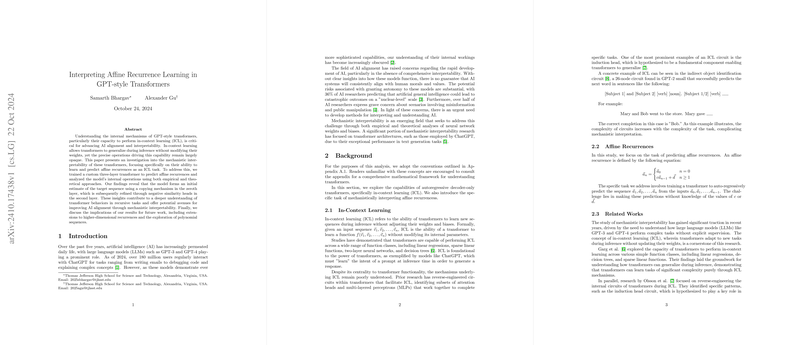Interpreting Affine Recurrence Learning in GPT-style Transformers
The research presented in the paper "Interpreting Affine Recurrence Learning in GPT-style Transformers" offers an in-depth investigation into the mechanistic interpretability of transformer architectures and their ability to perform in-context learning (ICL) on affine recurrence tasks. The paper focuses on understanding how transformers, specifically those modeled after the Generative Pre-trained Transformer (GPT) family, can generalize during inference without weight adjustment. Given the centrality of ICL to the functioning of models such as ChatGPT, which must infer and adapt to prompt intents in real-time, this work provides critical insights into the internal mechanisms of transformers that facilitate this ability.
Experimental Approach
The researchers crafted a custom three-layer transformer model designed to predict affine recurrences, employing both empirical and theoretical methodologies to explore the model's internal operations. The paper's approach was twofold: they first established a model to predict affine recurrences — sequences defined by a linear relationship between consecutive elements — without explicit information on key parameters, such as the linear coefficient. They then conducted a detailed analysis of the attention and value circuits within the model to identify how different layers and attention heads contribute to the prediction task.
Key Findings
The primary conclusions of this investigation reveal several noteworthy behaviors:
- Initial Sequence Estimation: The model utilizes a mechanism in the zeroth layer to form a preliminary estimation of the sequence using a copying operation. This layer aggregates residual stream information, effectively setting the stage for more refined calculations.
- Refinement via Negative Similarity Heads: In the second layer, certain attention heads, termed "negative similarity heads," subtract information that correlates negatively with the sequence prediction. This refinement is crucial for correcting overestimations introduced in the zeroth layer.
- Distinctive Circuit Interactions: The attention and value circuits in the second layer depict a unique pattern, often resembling negative identity matrices, which highlights the specific roles these layers play in subtracting similar vectors from the final prediction.
- In-context Learning Mechanics: The findings underscore the utility of negative copying mechanisms within transformer architectures, showcasing their potential to aid in predicting sequences without reliance on direct supervision.
Implications and Future Work
This research significantly contributes to our understanding of how transformers can be trained and interpreted mechanistically when applied to recursive numerical tasks. These insights could foster further advancements in AI alignment by refining methodologies that elucidate model behaviors, thereby enhancing transparency and predictability in AI applications. Practically, these findings can inform the development of more robust models capable of interpreting and generating complex sequences, with potential applications spanning natural language processing, financial forecasting, and scientific computing.
The authors propose several avenues for future exploration. These include extending the analysis framework to higher-dimensional affine recurrences and exploring polynomial sequence prediction. Moreover, the paper's methodological innovations, such as employing the Moore-Penrose pseudoinverse for validating identity-like functions of QK circuits, may inspire new approaches in the automated identification of neural network circuits.
In conclusion, this paper presents a comprehensive analysis of transformer mechanisms in the context of recursive task prediction, paving the way for more interpretive clarity and potentially enhancing the theoretical advancement of AI models engaging in complex inferential tasks.
